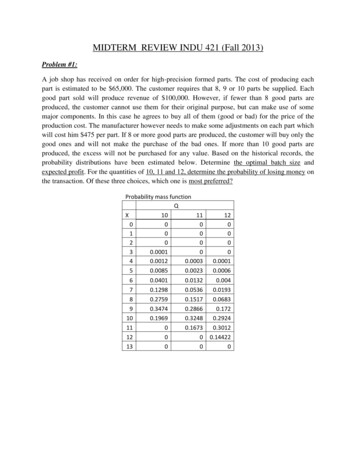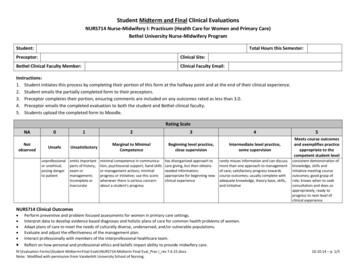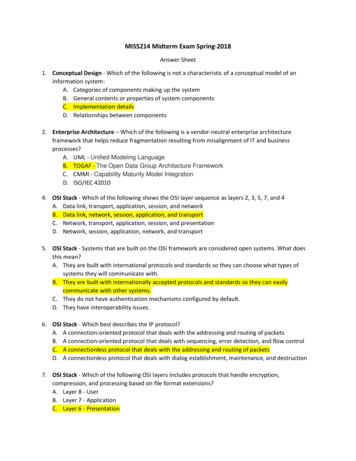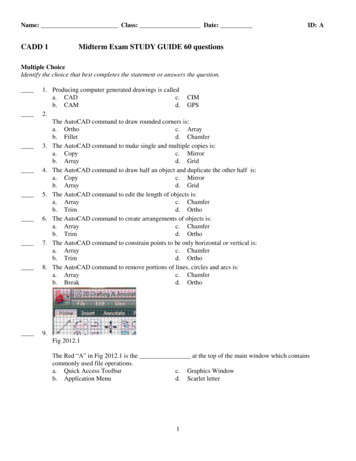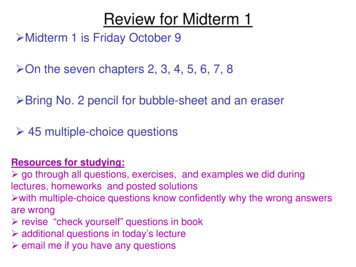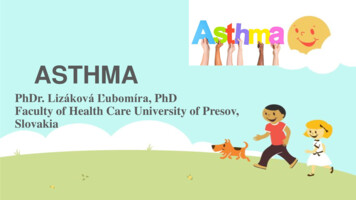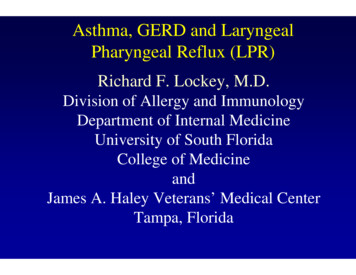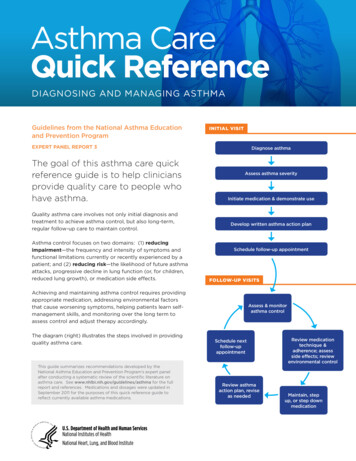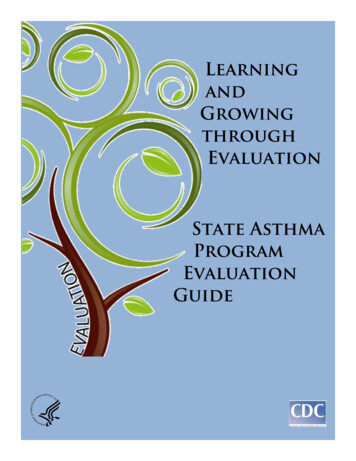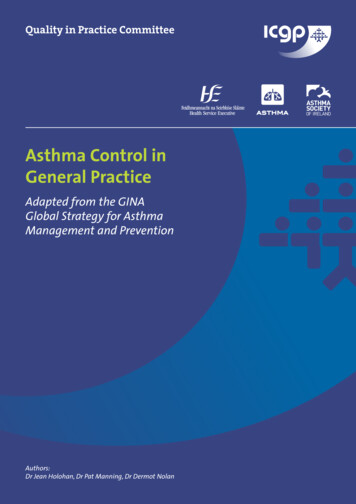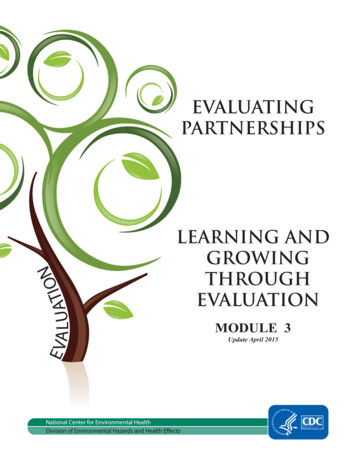
Transcription
N12 Midterm 2Asthma (PM)Pathophysiology of AsthmaAsthma is a disorder of the bronchial airways characterized by periods of reversible bronchospasm.Environmental factors interact with inherited factors to produce disease. Other inciting factors can include:o excitatory states (stress, laughing, crying)o exerciseo changes in tempo strong odors.Asthma involves a chronic inflammatory process that produces mucosal edema, mucus secretion, andairway inflammation. When exposed to allergens or irritants, airways become inflamed, producingshortness of breath, chest tightness, and wheezing. Initial clinical manifestations develop immediately andlast about an hour. About half of asthma clients also experience a delayed reaction that begins 4 to 8 hoursafter exposure and may last for hours or days.Clinical Manifestations of AsthmaAsk clients to rate dyspnea ono Dyspnea and marked respiratory effort (nasal flaring, pursed-lipa scale of 0 to 10.breathing, and use of accessory muscles)o Cyanosis is a late development.o Wheezing, especially during expiration. The inability to auscultate wheezing in an asthmatic clientwith acute respiratory distress may indicate that the small airways are too constricted to allow anyair flow. The client may require immediate, aggressive medical interventiono Brochospasm may lead to near continuous coughing in an attempt to exhale and clear the airway.Medical Intervention for Severe Asthma Episodeso Maintaining patent airway by relieving bronchospasm & clearing excess/retained secretions.o Maintaining effective gas exchange.o Preventing complications, such as acute resp failure & status asthmaticus.Controlling inflammation is key. Mucosal inflammation is controlled through the use of inhaledcorticosteroids that prevent the mast cell from emptying, reducing edema and spasm. Mast cell stabilizerssuppress the release of bronchoconstrictive substances during antigen-antibody reactions. Leukotrienemodifiers are used in the tx of both acute and chronic asthma. Leukotrienescause smooth muscleconstriction, increased vascular permeability, edema of the airway mucosa, mucus release, and inhibitedmucus clearance.Nursing Interventions & Diagnoses (Asthma)o Ineffective breathing pattern.o Monitor ABGs and SpO2. Fowler’s position. Compare pulmonary function test results withnormal levels.o Ineffective Airway Clearance1
o Suction secretions as necessary. Monitor color & consistency of sputum. Have clientcough productively. Encourage oral fluids to this secretions. Increase humidity of roomslightly.o Impaired Gas Exchangeo Assess lung sounds q h. Assess skin/mucous membrane color for cyanosis. MonitorSpO2. Administer O2 as ordered to maintain optimal SpO2.o Knowledge Deficito Nebulized medications can be difficult to learn to use. Observe use of nebulizer. Becertain the client knows what manifestations require use of nebulizer.o Risk for Decisional Conflicto Asthma prevention may require lifestyle changes: Pets may remain in house, but should not sleep with client. Encourage client to stop smoking and teach about dangers of second-handsmoke. Potential improvements related to a major lifestyle change, such as changing jobsor giving up pets to reduce exposure, may be offset by the stress felt from such achange. Holt-Oram Syndrome (AKA: heart-hand syndrome)Holt-Oram syndrome is an inherited disorder that affects bones in the arms and hands (the upper limbs)and may also cause heart problems. Prognosis is generally good, but itDo our patient’s arm/handdepends on the severity of the cardiac malformations. All people with thisabnormalities inhibit her use of thedisorder have at least one limb abnormality that affects bones in the wristinhaler? Is further teaching or(carpal bones), and can also include a missing thumb or a thumb that looksadaptation required?like a finger, partial or complete absence of bones in the forearm, anunderdeveloped bone of the upper arm, and abnormalities that affect the collar bone and shoulder blades.Bone abnormalities may affect each arm differently, and in these cases the left side is usually affected morethan the right side. Sometimes, only one arm and/or hand (on either the right side or the left side) isaffected.About 75 percent of individuals with Holt-Oram syndrome have heart problems. The most common problemis a defect in the or septum that separates the right and left sides of the heart. The deft can affct the atrialseptum (ASD) or the ventricular septum (VSD).Sometimes people with Holt-Oram syndrome have cardiac conduction disease, which is caused byabnormalities in the electrical system that coordinates contractions of the heart chambers. Cardiacconduction disease can lead to problems such as bradycardia, or a rapid and ineffective contraction of theheart muscles (fibrillation). Cardiac conduction disease can occur along with other heart defects (such asseptal defects) or as the only heart problem in people with Holt-Oram syndrome.Medical CareEvaluation can usually be performed in an outpatient setting, but inpatient studies and surgical treatmentmay be necessary. Patients with advanced heart block may require a permanent pacemaker. Surgicaltherapy can be used to correct cardiac defects or to possibly improve limb function.2
Surgical CareASD and VSD can be corrected surgically if pulmonary hypertension or ventricular failure has notdeveloped. Children with severe limb anomalies can be referred to orthopedic surgeons for consideration ofprocedures such as pollicization of the fifth digit (to improve upper limb function). Children with severe limbshortening may benefit from prostheses.Medicationo Antibiotic prophylaxis should be applied following standard AHA guidelines for patients withcongenital heart disease.o Anticoagulation should be considered in patients with pulmonary hypertension.o Cardioversion, antiarrhythmic drug therapy, or anticoagulation should be considered in patientswith atrial fibrillation.Complications of Holt-Oramo Congestive heart failureo Arrhythmiao Heart blocko Atrial fibrillationo Infectious endocarditiso Sudden deathPatient Educationo autosomal dominant disordero 50% that offspring of an affected individual will also have the disorder.o Severity of lesion in parent is not an indication of the potential severity in offspring.AlcoholismAlcohol abuse results in specific health problems, including withdrawalsyndrome, hepatitis, cirrhosis, pancreatitis, cancers of the liver, oropharynx, andesophagus, as well as an increased risk of breast cancer.Alcoholics also have anincreased mortality from allcauses, beginning with fourdrinks a day for men and twodrinks a day for women.Prompt recognition of withdrawal symptoms can promote client safety andprevent complications. Early clinical manifestations of alcohol withdrawal(tremors, anorexia, anxiety, restlessness, insomnia) tend to occur within 6 to 8hours after the last drink is ingested. During the next 2 to 3 days, the client may further experiencedisorientation, nightmares, abdominal pain, nausea, diaphoresis, and elevations in temperature, pulse, andblood pressure along with visual and auditory hallucinations. Delirium tremens (DTs) is a manifestation ofsevere alcohol withdrawal or its life-threatening complications. The clients with DTs is at risk for cardiacdysrhythmias, hypertension, increased resp, profuse sweating, delusions, and hallucinations.Many clients are given medications to decrease the incidence of withdrawal manifestations and to preventDTs. The benzodiazepines are commonly used because they cause less respiratory depression and HTNcompared with other drugs. Naltrexone hydrochloride decreases the craving for alcohol and facilitatesclient compliance with Tx. The social model, or the nonmedicinal Tx model, incorporates the use ofextensive physical exam, followed by close medical supervision during therapy.3
Nursing Interventions for Alcoholismo Offer continuous monitoring of manifestations.o Provide safe, calm, and comfortable environment.o Offer reassurance and support.o Address with the client the relationship between drug use and health problems.Influenza A/ AKA “avian influenza virus”Though the risk of infection from influenza A is low, confirmed cases of human infection from severalsubtypes of avian influenza infection have been reported since 1997. Most cases have resulted fromcontact with infected poultry or surfaces contaminated with secretion/excretions from infected birds. Thespread of avian influenza viruses from one ill person to another has been reported very rarely, and hasbeen limited, inefficient and unsustained.“Human influenza virus” usually refers to those subtypes that spread widely among humans. There are onlythree known A subtypes of influenza viruses (H1N1, H1N2, and H3N2) currently circulating among humans.It is likely that some genetic parts of current human influenza A viruses came from birds originally. InfluenzaA viruses are constantly changing, and they might adapt over time to infect and spread among humans.Symptoms of avian influenza in humans have ranged from typical human influenza-like symptoms (e.g.,fever, cough, sore throat, and muscle aches) to eye infections, pneumonia, severe respiratory diseases(such as acute respiratory distress), and other severe and life-threatening complications.What are the risks to human health?Diagnosed via nose oro risk of direct infection when the virus passes from the infected bird tothroat swab during first fewdays of illness.humans, sometimes resulting in severe diseaseo the risk that the virus – if given enough opportunities – will change into aform that is highly infectious for humans and spreads easily from person to person.How is avian influenza in humans treated?Studies done in laboratories suggest that the prescription medicines approvedfor human influenza viruses should work in treating avian influenza infection inhumans. Virus can become resistant, so they may may not always work.Seasonal influenza vaccine doesnot provide protection againstavian influenza.Infection controlIn the United States, disposable surgical and procedure masks have been widely used in health-caresettings to prevent exposure to respiratory infections, but the masks have not been used commonly incommunity settings, such as schools, businesses, and public gatherings.S. Aureuso About 20% of the population are long-term carriers of S. aureuso Frequently found in the nose and skin of a personS aureus is a gramo Can cause a range of illnesses from minor skin infections, such aspositive cocci.pimples, impetigo (may also be caused by Streptococcus pyogenes),boils, cellulitis folliculitis, furuncles, carbuncles, scalded skin syndrome and abscesses, to lifethreatening diseases such as pneumonia, meningitis, osteomyelitis, endocarditis, Toxic shocksyndrome (TSS), and septicemia.4
o It is still one of the four most common causes of nosocomial infections, often causing postsurgicalwound infections.Treatmento penicillino in most countries, penicillin-resistance is extremely common and first-line therapy is mostcommonly a penicillinase-resistant penicillin (oxacillin or flucloxacillin).o Combination therapy with gentamicin may be used to treat serious infections like endocarditis, butits use is controversial because of the high risk of damage to the kidneys. The duration oftreatment depends on the site of infection and on severity.Bi-Level Positive Airway PressurePositive airway pressure (PAP) is a method of respiratory ventilation used primarily in the treatment ofsleep apnea. It is also used for pts in respiratory failure, and in neonates. In these patients, PAP ventilationcan prevent the need for endotracheal intubation, or allow earlier extubation.BiPAP (Bilevel Positive Airway Pressure) provides two levels of pressure:o Inspiratory Positive Airway Pressure (IPAP), and ao lower Expiratory Positive Airway Pressure (EPAP) for easier exhalation.There are three modes of use for the BiPAP.o S (Spontaneous) - The device triggers IPAP when flow sensorsdetect spontaneous inspiratory effort and then cycles back toEPAP.o T (Timed) - The IPAP/EPAP cycling is purely machine-triggeredat a set rate, expressed in breaths per minute (BPM).o S/T (Spontaneous/Timed) - Like spontaneous mode, thedevice triggers to IPAP on patient inspiratory effort. But inspontaneous/timed mode a "backup" rate is also set to ensurethat patients still receives a minimum number of breaths perminute if they fail to breathe spontaneously.Optional features of the deviceo A heated water chamber can increase patient comfort by humidification. The temperature canusually be adjusted or turned off to act as a passive humidifier if desired. In general, a heatedhumidifier is either integrated into the unit or has a separate power source (i.e. plug).o For passive humidification, air is blown through an unheated water chamber and is dependent onambient air temperature. It is not as effective as the heated humidifier described above, but still canincrease patient comfort by eliminating the dryness of the compressed air. This is usually aseparate unit and does not have a power source.o Ramp is used to temporarily lower the pressure to allow the user to fallasleep more easily. The pressure gradually rises to the prescribed levelOptional features generallyover a period of time that can be adjusted by the patient and/or theincrease the likelihood of PAPDME provider.tolerance and compliance.o Exhalation pressure relief gives a short drop in pressure duringexhalation to reduce the effort required. This feature is known by the5
trade name C-Flex and EPR.o Flexible chin straps are used to help the patient to not breathe through the mouth, thereby keepinga closed pressure system. The straps are elastic enough that the patient can easily open his mouthif he feels that he needs to.o Data logging records basic compliance info or detailed event logging, allowing the sleep physician(or patient) to download and analyze da
Nursing Interventions & Diagnoses (Asthma) o Ineffective breathing pattern. o Monitor ABGs and SpO2. Fowler’s position. Compare pulmonary function test results with normal levels. o Ineffective Airway Clearance Ask clients to rate dyspnea on a scale of 0 to 10. 2 o Suction secretions as necessary. Monitor color & consistency of sputum. Have client cough productively. Encourage oral fluids to .
